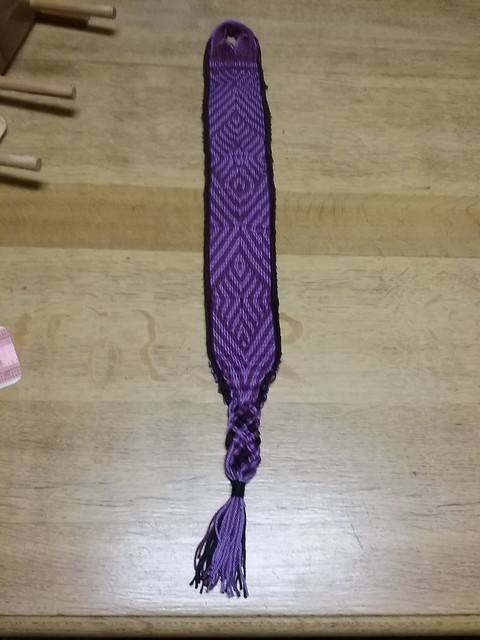Look at what la avispa has done with her latest belt - she's woven it straight onto a buckle, which is a brilliant idea.
 The tablet weaving I've shown you so far had all the cards threaded the same way at the start. It didn't matter which way, as long as they were all the same - though if you flipped some of the cards part way through, you effectively reversed the threading direction.
The tablet weaving I've shown you so far had all the cards threaded the same way at the start. It didn't matter which way, as long as they were all the same - though if you flipped some of the cards part way through, you effectively reversed the threading direction. Now, I'm going to show you a simple repeating pattern in which the cards are threaded diffently from the start.
If you look at the hatband below (modelled by my lovely husband), you'll see that the 'stitch' direction is symmetrical across the middle of the band and that 's due to the cards being threaded in opposite directions.
You'll also notice, if you look carefully, a 'v' patter along each edge. This is known as a 'warp-twined border' and gives a neat edge that helps the completed band to lie flat.

Now, we have to introduce a few technical terms:
Looking at the diagram below, you'll see the letters ABCD down one side. These letters represent holes in an individual card. The numbers represent the number of the card in the pack.


Remember this playing card from way back at the beginning of my tablet weaving discussions? If we look at the chart, we can see that for this pattern, card 4 has black thread in hole A, white in hole B, black in hole C and white in hole D.
(In my case, black and white became purple and lilac) there are a total of 40 dark and 24 light threads (4 x 16 in total)
Some people label the holes clockwise, some anticlockwise. Most times it won't make any difference as the pattern will just come out reversed and you're pretty much bound to reverse the direction sometime during the weaving in any case, (but if you're doing a really complicated pattern from a chart, you may want to check.)Now, you may have noticed the little arrows below the chart. These are important and potentially very confusing.

Here, we have to talk about S and Z threading.
Imagine you have the cards all threaded and the warp threads tied to your belt ready to start weaving, now, visualise one of the cards. The threads will enter a hole on one side of the card and come out the other side. Look down on your cards from above and think of the direction of the central stroke in a capital S and Z and compare with the slant of the thread in the diagram.
The left-hand card is S-threaded and the right hand card is Z-threaded.
Some people use the terms left and right when talking about threading directions. I find this incredibly confusing as it all depends on how you visualise the terms. (I visualised them the opposite way to the writer of the first book I read and I still rely on my pencil notes in the margin of the book to remember what she actually means.)
I suggest you convert all references to right and left threading to S-threading and Z-threading.
An arrow -> like card 1 in the threading diagram will be called left to right, but is acutally Z-threaded.An arrow on a threading diagram like
<- in the diagram above for cards 2-8, often refered to as being threaded
right to left is actually
S-threaded.
You'll notice that the edge card is threaded the opposite way to the one next to it. That's how you do the warp-twined border.
To carry out this pattern, you simply thread the cards, start turning the pack forward, and keep turning it forward with a shuttle pass on every turn. When you've either got the length you desire, or have too much twist to carry on (more likely the latter), then change direction and turn backwards until you have as much twist as you can handle, etc.
The warp-twined border will look after itself.
NOTE - in patterns with frequent changes of direction, the warp-twined border will need different handling. I'll deal with this when I move onto double-faced weaving. Double-faced weaving is not suitable for a first project in tablet-weaving, but it is very versatile and can be used to weave anything from space invaders to alphabets.
NOW- why not try either the pattern above, or play with some squared paper and see what designs you can come up with yourself. You can use as many different colours as you like and you can use any width of band (within reason), but you only have four rows to create your pattern in.




































